The Blanco Dish Furthest From Popular Chocolate Moles
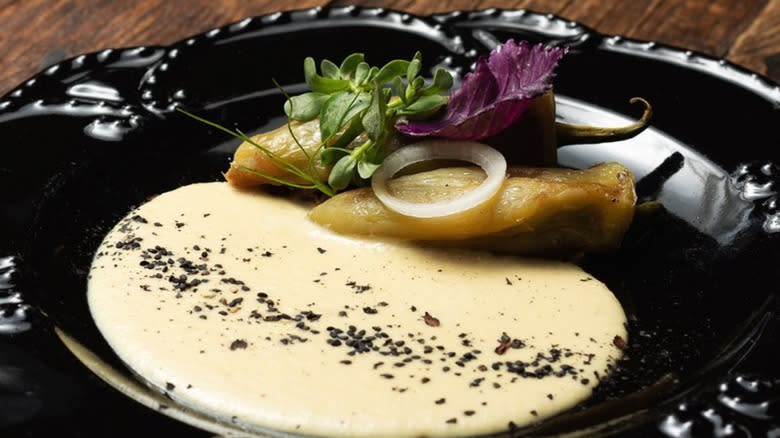
If you've eaten an entree sauced with mole in a Mexican restaurant north of the Rio Grande, there's a good chance that the mole sauce was fairly dark. This is due to the fact that mole poblano and mole negro, which typically contain chocolate or cocoa powder, are among the most commonly-known varieties. Other popular moles are red, yellow, or green due to the chiles and other ingredients with which they're made. Mole blanco, however, is a pale horse of a different color.
Mole blanco, too, is named for its color as "blanco" is the Spanish word for "white." The sauce may not exactly be as pure as the driven snow (unless that snow has been driving along a dusty road), but it is creamy in color as well as consistency. Another name for the sauce is mole novia or "bride mole," which may again be a reference to the color because Mexican brides, too, wear white. It could also refer to the fact that this sauce may be reserved for holidays and special occasions like, well, weddings.
Read more: US Foods You Surprisingly Can't Find In Canada
Origin Of Mole Blanco
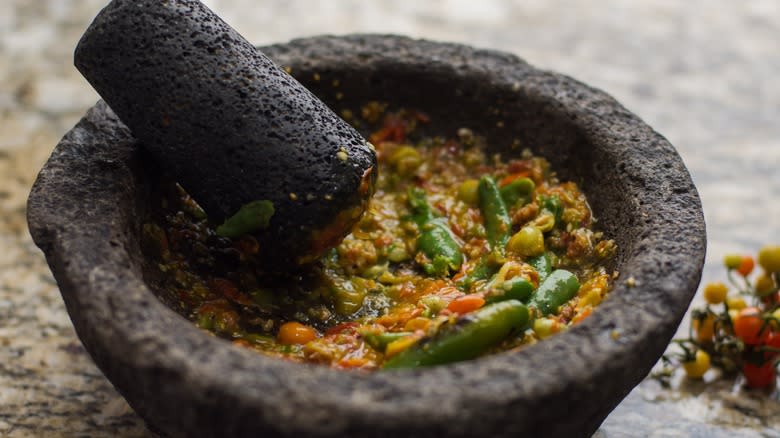
Mole blanco was invented in 1824 by a woman named Josefina Montoya. Kidding! As American Girl franchise fans may recall, Josefina had all manner of intrepid adventures throughout the course of that year, but culinary innovations were not in her skill set. She was from New Mexico, anyway. but mole blanco is a product of Old Mexico, instead. It comes from the Mixteca region of Oaxaca, which is a state that's famous for seven different kinds of mole sauces. Blanco, however, is notably absent from the list despite the fact that it's much easier to make (and looks less likely to stain) than its opposite number, the complex mole negro.
Apart from this place, we really don't have much more info about when and how mole blanco came to be, so we'll have to file it under "traditional" which is a blanket historian term meaning that somebody at some time thought that doing such-and-such was a good idea, and whaddya know? Their neighbors agreed and started doing it, too. Back in the day (whatever day that was), mole blanco was likely prepared in a molcajete, which is a mortar and pestle made from solidified lava. The use of a molcajete alone does little to help us nail down a date since many still use this low-tech tool today, but it's probably safe to say that mole blanco long predates the introduction of the blender in the 1930s.
What Goes Into Mole Blanco?
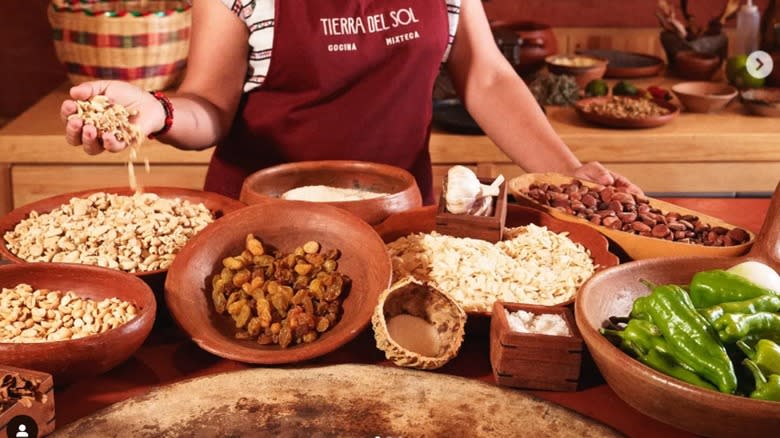
Mole blanco, as with many traditional recipes, doesn't seem to have any one widely accepted recipe. As a general rule, it typically contains chiles such as habaneros and serranos, which may give it a greenish or yellowish tint. It could also pick up some yellow from chicken broth, plus it might have peanuts or cashews lending some brownish color. On the whiter end of the color spectrum are coconut oil, garlic, onions, almonds, and pine nuts. The resulting shade, even if not snowy white, is meant to be no darker than beige.
Once you start taking a look at contemporary recipes for mole blanco, however, you'll find that other add-ins frequently find their way into the mix. Some recipes will use additional seasonings such as anise, cinnamon, coriander, and cumin, while others call for fruits like apples, apricots, bananas, and golden raisins. Mole blanco may also include sherry, and there are even recipes made with white chocolate or cocoa butter. In the case of these last two ingredients, it leads one to wonder whether the recipe developers were perhaps interpreting all moles as sauces that need to include some type of chocolate or chocolate-adjacent ingredient, although there are many other traditional moles besides mole blanco that typically do not contain the stuff.
How To Make Mole Blanco
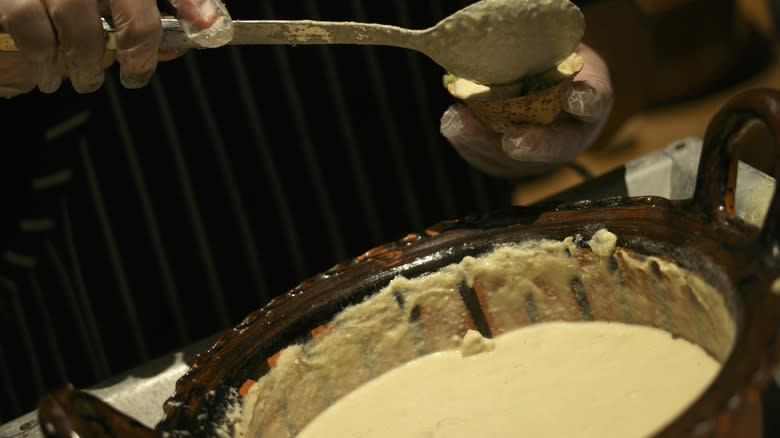
Just as there is no one accepted recipe for mole blanco, so, too, is there no one way to make it. There are two main elements to the preparation, one being grinding or blending some (or all) of the ingredients and the other involving cooking some (or all) of the ingredients.
In some recipes, everything, nuts and all, goes into a frying pan and cooks until it softens, while other ones start off by pureeing all of the ingredients, including onions and peppers, while they're still raw and then cooking them to make the mole. Some cooks will choose to use an immersion blender to mix up the sauce while it is cooking. True, this may not be the most traditional of methods because the immersion blender itself is a European invention that dates back no further than the 1950s. But at this point, it really doesn't matter. As long as the mole ingredients are both cooked and pureed at some point, neither the tools employed nor the order in which the steps occur makes much difference.
How To Eat Mole Blanco
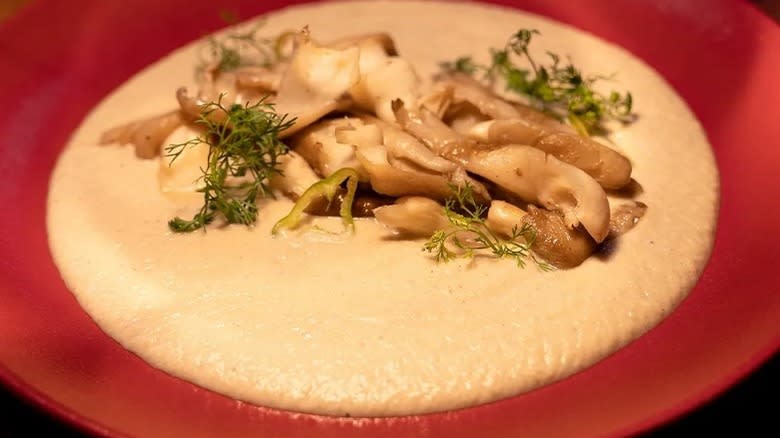
As mole blanco is a sauce, not a stand-alone dish, this means you wouldn't typically just eat it by the spoonful (at least, not if anyone's looking). Instead, it's generally used to, well, sauce things. What sorts of things, you may ask, and we may answer: In its native Oaxaca, the most traditional way to eat it is with a type of flower that is said to taste of green beans (and, as such, is probably not too popular in bouquets or perfumes). In the absence of bean-flavored blossoms, though, it's frequently served with light-colored meats such as fish, poultry, pork, and rabbit.
Mole blanco need not be restricted to serving as a sauce for meats. It goes well with vegetables, too, and is often used as a topping for chiles rellenos. While it may not be quite as common a chip dip as pico de gallo or other types of salsa rojo, you could certainly use it for this purpose if you wish. Chips made from flour tortillas might work particularly well with mole blanco's delicate flavors.
Where To Find Mole Blanco
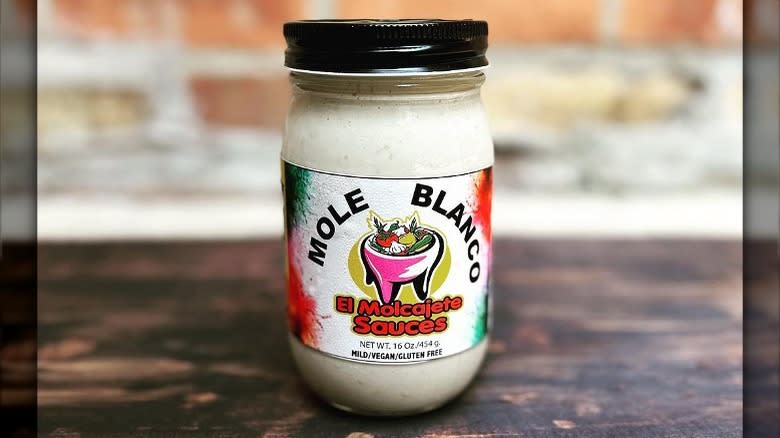
Mole blanco is one of the less common kinds of mole, and as such, isn't particularly easy to come by here in the U.S. Widely-varying recipes abound for do-it-yourselfers, but if you'd like to try this sauce without having to cook it, your options are limited. It does seem that a prepared version is available from El Molcajete Sauces. Although the company is based in Oaxaca, the sauce, along with various other types of mole, may be purchased from its website where it is currently (as of publication) priced at $13 per jar.
Mole blanco may also be found on the occasional restaurant menu. Tierra del Sol, also in Oaxaca, offers a vegetarian dish of mole blanco-sauced mushrooms. North of the Rio Grande, Austin's El Naranjo may have sesame-cashew mole blanco over halibut on its summertime menu, while Santa Fe's Sazon sometimes serves its mole blanco atop sea bass. Chicago's Roister has been known to feature mole blanco as part of a multicultural tasting menu, while Brooklyn's La Morada sticks to preparing theirs straight-up Oaxacan style and serving it with various types of Mexican food including plain old rice and beans.
Read the original article on Mashed.


